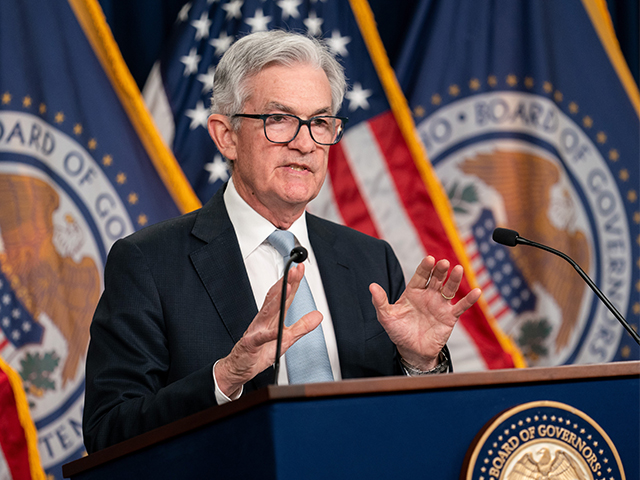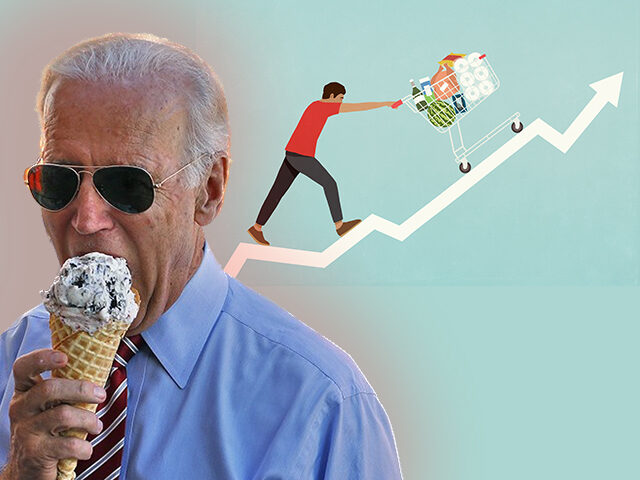Inflation Was Cool But Not Cooling
The Federal Reserve probably got what it wanted in the July inflation numbers. The Biden administration was not as lucky.
The consumer price index (CPI) rose just 0.2 percent for the second month in a row. This was in line with consensus expectations and an indication that the cooler inflation we saw as summer began has continued.
If we dig a bit deeper, the inflation numbers are even better. Inflation was up 0.16686 percent before rounding, which meant that the annual increase was just 3.2 percent, slightly lower than expected. This means that inflation actually fell a tiny bit month-to-month because the June figure was a gain of 0.18035 percent before rounding. Let’s call that a tick down from 0.18 to 0.17 percent.

(iStock/Getty Images)
Core inflation, which excludes food and gas prices, rose 0.2 percent, just as it had the prior month. If we look at the unrounded figures, there was actually a slight uptick from 0.15756 percent to 0.1595 percent. That is, however, a level of fake precision that the consumer price index estimates probably do not support. Call it 0.16 percent to 0.16 percent, unchanged from the month-to-month.
The market took this as a positive sign that cooler inflation continues to prevail. This may be a bit too positive of a view. Holding the month-to-month inflation rate even is obviously not a sign that inflation is coming down. In fact, as the base effects kick in from cooler inflation in the back half of last year, holding the monthly numbers even will raise the year-over-year numbers.
Fed May Pause in September
This should matter to the Federal Reserve—although it might not. Fed officials have repeatedly said they wanted to see multiple months of data showing that inflation is reliably moving down to the Fed’s two percent target. That’s not what we’re seeing in the June and July numbers. Instead, it appears that inflation may be becoming entrenched at a higher level.
That’s not a problem for those who think that the Fed should reset its target at a higher rate to accommodate an era that is prone to higher inflation. Fed Chair Jerome Powell, however, has been adamant that the Fed is not going to abandon the two percent target. If the Fed sticks to its guns, monetary policy will likely have to tighten further to bring inflation down to the target.
Still, the number is probably good enough for the Federal Reserve to wait until November to raise rates, skipping the September meeting. We think the Fed was already inclined to adopt this every other meeting pace of hikes, and so it will likely take the opportunity to pause while more data comes in.

Federal Reserve Board Chairman Jerome Powell speaks at a news conference following a Federal Open Market Committee meeting in Washington, DC, on November 2, 2022. (Liu Jie/Xinhua via Getty Images)
That could change, however, if the August jobs and wages figures or the August CPI numbers—which will be released before the September Fed meeting—come in hot. If inflation appears to be regaining momentum, the Fed will likely want to act sooner rather than later.
We do take some reassurance from the downward move in median CPI. The Federal Reserve Bank of Cleveland said Thursday that median CPI fell to a monthly rate of 0.2 percent after running at 0.4 percent for the previous four months. This could be an indicator that underlying inflationary pressures are finally easing.
On the other hand, 16 percent trimmed mean inflation has been stuck at 0.2 percent for four out of the past five months (it was 0.3 percent in April). That could be an indication that we have hit a floor for inflation—or “peak disinflation” as James Bianco of Bianco Research has termed it.
Food and Gas Inflation Is Political Poison for Biden
Politically, the July CPI numbers were not good news for the Biden administration. Food prices are rising again, with the price of groceries climbing a sharp 0.3 percent for the month after holding more or less steady in June. Before rounding, this was 0.27 percent, the steepest month-to-month gain since January. Gas prices rose 0.2 percent after rising one percent in June. Food and gas prices are the most politically salient parts of the consumer price index because they are encountered so frequently and make up large and inflexible parts of household budgets for middle and lower-income earners.
Food inflation looks likely to continue to run hot due to rising transportation costs and unfavorable weather. Wall Street analysts say El Nino is also likely to exert upward pressure on food prices. This will make it harder for the Biden administration to convince Americans that it is getting inflation under control. Claims that inflation is coming down will likely just make the Biden administration look out of touch with the public.
Inflation remains the top issue for Americans, according to opinion polls. The latest poll from the Economist/YouGov has 71 percent of the public rating inflation as “very important” and another 21 percent saying it is “somewhat important.” Biden’s approval rating on inflation is badly underwater, with 58 percent disapproving and just 34 percent approving. If we look at just the “strongly” disapprove to approve numbers, the gap is even wider: 46 percent strongly disapprove and just 13 percent strongly approve.
Fifty-nine percent say the inflation has had a lot of impact on their life. Thirty-seven percent say it has had a little bit of an impact. Only four percent say they haven’t felt it at all.
And Americans do not think the inflation picture will improve. Forty-six percent say they expect inflation to be higher six months from now, 24 percent expect it to be about the same, and 13 percent expect a lower rate of inflation.

COMMENTS
Please let us know if you're having issues with commenting.